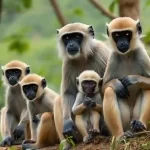Preamble:
In the middle of March, clouds are getting together in the sky. After gazing at the heaped dark clouds for some time, Ramdin Baiga, the experienced guide of Bandhavgarh forest, said in a low tone by provoking the theory of possibility, ‘ Sir, this is the ideal environment to see tigers, leopards and bears.’ In the suddenness of words and in the thoughts of the future to come, Rumki, the youngest member of our team, swallowed quite a bit of water. We have come in search of situations of the Bandhavgarh tiger victims in Madhya Pradesh. Now, hoping to see tiger and respecting the conventional system followed by the travelers, we, a team of five persons, ride a zip safari in the Tala zone of Bandhavgarh National Forest. The National Forest Department has divided the Forest into three zones; Tala, Magadhi and Khitauli. Now, at the time of entrance we get a leisure period as the security officers of the Forest are checking the requisite papers.
In this leisure period, let’s get an introductory episode of Bandhavgarh which is situated at the side of Rewa- Umaria road under district of Umaria. The area is spread within 3629.7 sq. km but the buffer area of Jungle is 450 sq. km. and the core area is 105 sq. km only. According to mythological and popular concept, after the victory of SriLanka and returning to Ayodhya, SriRamchandra gave this land to his brother (Bandhav) Lakshman by establishing a fort (garh) here to keep an eye on SriLanka. Both the words Bandhav and Garh construct the word Bandhavgarh. Between 23.41 northern latitude and 81.3 eastern longitude, there is an old fort situated at the main Bandhavgarh hill which is surrounded by 32 other small hills with a height of 2662ft. above from the sea level. Most of the names of the hills are the mythological names such as; – Bandhaini, Hanuman mancha, Sitamandap, Bamania, Mahamaya etc. The river-irrigated area is Bandhavgarh. The main rivers are Shone, Mahanadi, Dhotachar, Juhila etc. At the time of rainy season their form is terrible and much of the areas are flooded even if they are lean and dry in most of the months in a year.
Jungle Diary:
After entering into the core area of the forest from the buffer zone, the trees are becoming dense to denser. The driver of our jeep is carrying the orders of the experienced guide Ramdin Baiga stoically to fulfill our long cherished purposeful desire. On the way a lot of monkeys, a herd of deers, Sambhar, Nilgai, a pig team and a jackal are met by us. Ramdin Baiga has taken an opportunity to emit his treasure of knowledge about Bandhavgarh Forest as soon as we meet these animals. It is heard from him that there are Monkeys, Languor, Rhesus, Wolves, Asiatic Jackals, Foxes, Hyenas, Sloth Bears, Honey Badger, Mongoose, Wild Cat, Wild Boar, Armadillos, and Dhole, a special type of Wild Dogs, except Tigers and Leopards. There are also Porcupines, Gaurs, Fishing Cats, Civet cats, Squirrels, large size rats and different species of deer such as, Chital, Nilgai, Chaushinga, Chinkara and Sambar. There are more than 22 species of animals, 250 species of birds (according to another opinion 300), 80 species of butter flies, five species of bats and different species of snakes.
All in a sudden, everyone casts a glance to a hole of a tree in the left side as directed by Ramdin with an excitement. Surajit keeps his eye on binoculars which is always hanging vertically from his neck. A terrified nocturnal creature is appeared through his lens. The lips of Rumki are curled slightly what the binoculars show her. Again Ramdin is excited as usual we too. Now it is to the right side. The cleverest creature of the fauna is sitting to soak up the setting sun. After entering into the core area of the forest and meeting such animals around her, Rumki, with utter despair and fatigue, said in a bitter tone, ‘After entering forest, in the first sight, merely a fox and an owl were seen by us; hope, that the day will be spend well.’
The day has not gone so badly by giving ash to the speculation of Rumki. Under the guidance of Ramdin, We have reached to the fort of Bandhavgarh by seeing the colorful peacocks and ramping of innumerable monkeys with the spectacular scenery of running together of different types of deer such as, Chital, Sambar, Chausingha, Nilgai in a rhythmic way. The safari jeep halts at the foot of Charanganga Lake. We have climbed the stairs to the edge of the small and naturally created lake. On the opposite side of us and on the bank of the lake, there is a thirty four feet long statue of Narayana, the creator of the universe, is sleeping on the bed of Shesnag Ananta with a round-shaped statue of Shivlinga on the head side of Narayana and a lean stream of water, coming out from the notch of the hillocks, is mixing with the lake at the feet side of Vishnu. There is also situated a small dilapidated idol of Nrisinghadeva on the Yonipith of Shivlinga.
Here Nature gives a golden opportunity to the photographers by revealing her treasure in ungrateful hands. Asoke and Rahul have opened their modern photographic equipments quickly to arrest the sublime nature. On the other side, Rumki and Surajit, the future couple, are busy to capture their self-portraits on camera by mixing with serene beauty of endless nature. Does this candid scene give birth to the realization of Browning, – ‘Who knows but the world may end tonight?’ The cosmos, however, remains silently indifferent to the balance of status. In this time of leisure, I and Ramdin are engaging ourselves by discussing the genealogy of the Bandhavgarh dynasty.
Tiger and We:
When the discussion is shaking hands with history, the heart is searching for its alleys, taken to a forgotten light, suddenly consciousness returns to Surajit’s word, let’s go, it’s over. The turn to capture nature by fulfilling the hopes of the photographers is over, now it is time to return. In the meantime, two more jeeps have come with the squeaky sound of the riders and distorted exhilaration. The parallels between nature and history lie in the misuse of modernity with an unspoken amour-propre.
On the way back Ramdin has taken another. A vast expanse of green carpeted stretch of land with a herd of deer is floating in front our eyes. And the monkeys are bullying with each other near the jeep. The fascination is broken by Ramdin’s low voice, Sir, see the tiger. There is a middle-aged yellow stripe sitting near the bushes. A stable gazing is focused on the herd of deer. What a concentration! Suddenly he gets up a little and starts walking towards the prey in a cat-catching manner. Immediately the yelling of monkeys is beginning to roar from one end of the forest to the other by breaking the stillness of the forest. This time the yellow flame is running towards the herd of deer. The deer that falls in the weakest inconvenient position is his target. But the tiger is failed by the pace of the deer; he gives up the effort with utter despair after running a few yards of distance.
The incident reminds me of the celebrated book, ‘The Serengeti Lion’, by George Schaller who made different types of experiments on lions for a long time in the region of Serengeti of Africa. One of the experiments was the probability to catch a prey by a lion; what was the probability rate in the first case, what was the probability rate in the second case, etc., i.e. an attempt to deduct a mathematical formula in this type of research. This formula does not give a verdict in favor of the hunting fauna.
Suddenly the silence of the nature is shattered by the sound of deep sigh. Breathing that can be so long and sonorous, is first felt. It is owned by original and genuine Rumki. But it is the bleeding in front of the eyes, not in the television; – a tiger is finishing the afternoon meal by breaking the neck of a deer, it will be not so easy to her. ‘The water of the river became red like the petals of a sprig; warm red deer meat was about to made’, – what is beautiful in the poet’s pen and also in the pages of poetry is a nightmare to Rumki. Such a failure of Darwin’s theory brings a radiance of ecstasy and great satisfaction to his eyes, all over.
The tiger is swaying back and forth in a regal manner. But which way is he coming? He is coming towards us! Everyone in the jeep is so speechless, still and terrified. Only Ashok keeps his camera active. Where his devotion is less than that of professional photographers? Me, Ramdin and Ashok are in the back seat. Once carelessly, the tiger crosses the road, glancing at the jeep and takes refuge under a tree. In another of Rumiki’s deep breaths, everyone has picked up a camera in their hands by overcoming the primary shock and then the magical forest of light and darkness is swept away by the spontaneous flash of the cameras. Gradually, the message has spread slowly; – a few more jeeps are coming getting the smell of tiger. The combination of progress, development and commercialization creates such a crisis; it makes my mind a little bitter. Can Ramdin understand the pain of the heart; otherwise the car is turned around and is going on somewhere else.
Now the path is secluded. Only we are going this way alone. No cars are seen here. Black clouds have taken all over the sky. At the farthest end of the horizon, the sound of thunder is heard; the rain comes down loudly as soon as the crooked sword of lightning is unsheathed and pierces the bosom of the sky. Not with umbrellas and raincoats, now there is no alternative but to get wet. Suddenly, instead of croaking noise, the peacock wandering in the small field to the left of our jeep screamed in terror. Ramdin immediately tells the driver to stop the jeep. We almost are said in an instinctive manner, ‘Look at the branches of the trees, it could be Tendua (Leopard).’ A little later he himself shows a large leopard lying in a branch of a tree not far away. Flash goes again. Movies are being taken at equal speed with static images. On a rainy evening, where nature is paralyzed, an unsavory montage is made by mingling with a lonely leopard lying on a tree branch, – this is the first time it is felt that the taste of universal bliss is actually created in the ingredients of reality. There is no limit to our debt to nature. After giving a long time to the travelers, the leopard which is becoming aware of the needless busyness of mankind comes down to earth. The painting is made smudgy; the subtle mural of unreality, formed with the pieces of reality and is reflected in nature, is now merged into the dust of the soil.
Everyone is silent for a while. Saying goodbye to the Bandhavgarh forest, the enchanting evening of clouds, all kinds of birds, animals and floras that have mixed their fragrance and made the indescribable nature sweet with melody, rhythm and aroma, – it is now time to return to the lodge. We will start our survey from the next day.
As we exit the lodge after eating and drinking at night, we see a cloudless starry sky. The sky holds so many stars in her bosom which is dirty with dust and dull in the city. Nature is here so real, so alive, so direct, so intimate, and so vast, that is unimaginable in the city where there is only an endless gap between man and nature and the beauty of the cosmos in a non-intimate sense is hidden behind a man-made wall. In the middle of night, the fox’s howl and the dog’s scream wake us up.
Men of Struggle:
Outside the lodge in the morning, the body of a baby dog is found torn apart by a fox attack. We have heard the scream of this puppy in the middle of the night. The survey cannot be conducted in the morning session; the people of the village will be busy with farming activities. There will be no work load in the afternoon. As a result afternoon is decided.
Part of the questionnaires we made was about the Bandhavgarh forest and the eviction of the local inhabitants from there because we heard before we came that the government wanted to evict them. That is why the first question is; did you or your ancestors evict from the jungle of Bandhavgarh before? The answer is found, yes three, not forty-seven and three without comment. The second question is about the date of eviction. No answers are found. The third question is, did the Government provide any grants or assistance for the eviction? One in three answers yes, one says no and one does not comment. The fourth question is type of grant and help from any sources, the only one in the answer says that he has got the land. The fifth question is extremely important. The question is, do you want the forest should be closed and all the lands to be distributed equally among you. Of these, forty eight persons have wanted the forest in Bandhavgarh to remain as it, three have given their consent that the jungle should be removed and two have not passed any remark. Those three people who are in favor of clearing the jungle are members of the same family. Harihar Baiga, son of Sukhanandan Baiga, is a resident of Dulhara village under Kadonga Gram Panchayet. Harihar is now forty years old. In the year 2017, he was attacked by a tiger while working in the field. At present, though he is alive but the part below the waist is almost crippled. He did not receive any financial assistance from the Government or the private sector. He is opposed to having the tigers as opposed to having jungles. His younger brother Chotu, age 23, is also opposed to having tigers and jungles due to his brother’s plight. Their mother Shrudhi Baiga, wife of Sukhanandan Baiga, is of age sixty and she is also a fierce opponent to having tigers and jungles in Bandhavgarh. At the time of conversation and during the interviews, their faces are clearly lit up with raging and tearful hatred against tigers, jungles, government, non-governmental organizations and babus like us who use them for their own needs. The innermost part of our heart is pierced by a thorn of guilt and discomfort and is also dented our well-organized thinking which believed that man had a stationary, powerful entity capable of always resisting external injury.
Do such thoughts are nourished by the inhabitants of this region on their minds? How can institutional opposition be explained? Let’s see what the opinion is in this regard. The question is what kind of organization they believe in conserving people, tiger and nature. Government organizations get the support of two, so also NGO’s, twenty-six people trust the panchayet, and twelve people trust the local administration, five people trust the forest department, four people trust no one and two people trust other organizations. It should be noted here that although there is no direct reliance on the government but it is good to rely on the organization of various branches of government. Their combined sum stands at forty five.
Harihar, who was crippled by the tiger’s attack, strongly advocates the removal of the forest and tigers, but he himself does not support the killings of the tigers, although the tone of the other members of the family was different. Sakuntala Baiga, the wife of Pancham Baiga who was killed in a tiger attack, Premabai Jadav, wife of Babulal Jadav and Sushila Singh, wife of Late Mahendra Singh, – all have more or less the same statement. All of them are residents of one place, village Kaluyava and Panchayet Dova. Sushila Devi’s voice is filled with terror, – when I woke up in the morning, and saw the print of the tiger’s paw in front of the door that scared me.
The type of speech is pretty much the same; most people don’t want the tigers to be wiped out but they want security. They are willing to leave the area if the government accepts their demands. It is up to the government to select places where they can earn a living. In this case they do not want any bargaining.
Most of the residents, about thirty, are talking about fencing with walls, five talking about fencing with barbed wire, eleven talking about fencing or wire mesh, three talking about moving out of the core and buffer area. One is saying it would be better cut the wide canal. One has given the verdict to encircle the area anyway. One has said about small perforated net and one has made no comment. To do all these arrangements by the government, a lot of money is needed. Will you pay the tax if the government imposes only two percent of tax for two years because of your security? Immediately fifty persons say ‘No’, three make no comment. But why not, what is the cause? We have placed before them eight reasons but everyone has identified only two reasons; one is, ‘I am willing to pay for the conservation of tigers but financially incapable’, and the second is, ‘It should be done by the existing funds of the government’. Twenty four have said in favor of the first, twenty five have got the second and four persons have made no comment.
The nature of our question is such that that simplistic artificiality would be easily removed. The deer that does not know the hunter would not be delayed to be pierced. A direct question is thrown, ‘Have you heard of tigers entering your locality?’ Everyone present, including fifty three persons participated in the survey, and has said yes. The conviction is awakening in the depths of the mind, as if that faithful simplicity is coming back. The second question is, ‘Have you seen tigers in your area?’ Forty nine persons have said that they saw the tigers but four have replied that they did not. The answers are being swept by the outer coverings of the previous artificiality. It is normal to see tigers in the paradise of tigers Bandhavgarh. The answer is making everyone happy. The third question is, did any of your acquaintances fall prey to the tiger? Nineteen persons have said yes, thirty four has said no. The story of Bandhavgarh is comprised of those marginalized people, who are destitute; homeless live in the swing of birth and death. The Government also does not want to pay extra attention except the marginalized condition whereas; the answer to the third question is their daily life and death story.
The last question at this stage is, should the tiger be saved? In answer to this question, forty three persons have said yes, two answers negatively and eight has said I don’t know. How can this paradox be explained, – the villagers are more interested in saving the tigers than in saving themselves and their livestock. If anyone reads the thoughts of Rahul and is able to turn into words then it will reveal his word of mind that those who are unable to provide a little money, why are they so eager to jump into the huge sacrifice like tiger conservation? Just because of this, the financial reasons are involved in the first; – all the responsibility falls on the shoulder of the government; in the second case it transforms on the world, because the statesmen including the environmentalists of the world are involved in saving the tiger. No! It is just an attempt to create an atmosphere of intellectual suspicion in fertile brain, ‘as if looking at each other in a crooked habit.’
Rather, let the thoughts transform in a different way. Both, tigers and human are children of nature. Tigers are a part of their daily life, if one is kept away and make them other, and then Bandhavgarh is interrupted and incomplete. By this time, the smoky, intellectual, crooked thoughts have vanished and the shadows of the forest and the fragrance of the inflorescence have developed in the grooved part of my brain. ‘You look at the people they want to say something.’
We are interested about the numbers of tigers whether it is increasing or decreasing. Ten persons have said too much, twenty two persons have told much, twenty one have answered well, but no one is agreed with less and sufficiently less on Surajit’s question. Surprising all of us on the back of this question, Rumki suddenly has thrown a question, what is the number of tigers you see compared to the last five years? Ten people have said that it has increased a lot; twenty seven people have said that it has increased, five people have answered that it is the same, eleven people have said that it has decreased and no one has answered that it has decreased a lot. The answer indicates that the number of tiger sightings has increased. The famous tigers and tigresses of Bandhavgarh were B2, Charger and Sita, they were also very popular with tourists. For example, a tiger called Bomera is currently the centre of attraction for tourists. One thing that can be said in context is the tiger holding capacity of the Bandhavgarh Forest. This forest does not have the capacity to hold more than 65 to 70 tigers. If the number of tigers exceeds this, they are moved to other forests, i.e. Satpura, Panna and Siupuri forests. Male tigers are usually shifted.
What is your opinion about the authorities taking action to save the tigers? In answer to Rahul’s question, eighteen persons have said ‘good’ that is indicating their verdict in favor of Forest Department, twenty-one persons have told insufficient, seven persons have said bad and another seven people have said, ‘I don’t know.’ This statistics indicates the indifference of the Forest Department to conserve the tigers. The death of tigress Sita in the hands of poachers proves that conservation is not of high quality and flawless. Ashoke have raised the most complicated question. What is your opinion about the actions of the authorities for the residents of the area? In answer to this question six have said well, nineteen have said insufficient and twenty eight persons have answered badly which shows that the distance between the forest department and the people of this area is infinite and the relationship has come to a standstill.
Talk about Problems:
A closer look reveals the allegations against the forest department by the people of the area. If a cow dies due to a tiger attack, the owner of the cow will get ten to twelve thousand rupees, if a buffalo dies; he will get twenty five thousand rupees, six thousand rupees are allocated for goats and only rupees two lakh and half are for human beings. Now the point is to collect this money from the government house, the sandals of the poor, illiterate and helpless people will be eroded. Who can tell if any of these related files would be wan and obsolete after remaining in the self of niche year after year without any offerings to the officials in the administrative department? That would pass all understanding human or divine.
Another important thing is that the government will pay if the cattle die by the tiger attack but there is no system to pay if they are injured. But they will get treatment. The same goes for human. For that Harihar Baiga didn’t get any money even though he was crippled by the tiger attack. Even more frightening the fact that if any cattle or humans survived from a tiger attack and died a few days later, then it is difficult to get money out of the government’s house despite the government’s financial provision to pay the victimized. Because the bones of the owner of the cattle or the family of the attacked persons will freeze to prove that the animal or the person died for that attack. If injured, one of the families should get a job. This is the rule of forest department. But the real speaks differently. Harihar Baiga is his shining proof. Another issue is that if someone dies in the buffer area, they will get compensation, but if someone dies in the core area they will not get the compensation because going to the core area requires permission from the forest department. Thus speaks Law. But if a pet goes to the core area at the time of gazing, then its owner will become utterly devoid of common sense under this circumstances. On the spur of the moment, the owner goes to the core area to look for his pet and he may be attacked by wild animals there and that is normal. Then the government will not take responsibility for the accident. To the poor people then, the water of pond is fire; the water of the well is ashes.
The second issue is the plan to evacuate villages adjacent to the forest. In this case, the government arrangement is to take the family out of the forest area with one million rupees per family. This has caused great anger among the families. Their demand is to pay at least 18 to 20 lakh rupees per family and the government should take the responsibility of rehabilitation. The amount of land for a house should not be less than three kathas. They live in a very open space. The place should be chosen in that way where the children’s education and medical facilities will be arranged properly. The communication system with the town should be well connected. In other words, the issue of small civic opportunities is coming up in the voices of the locals. They want to say, live a little longer in the joy of life. There is a pleading plea in the eyes of Shakuntala Baiga, wife of Pancham Baiga killed in the tiger attack, Premabai Yadav, wife of Babulal Yadav and Sushila Singh, wife of late Mahendra Singh. They all want to tell us ‘Dada, we want to live, let us live.’ Also the opinion of the residents of different villages around our survey like Garpuri, Saumahalla, Dova, Tala of Dova Panchayet; Tikuri of Tikuri Panchayet and Dulhara of Kachhonga Panchayet is quite similar. Most people do not want the tiger to be wiped out but they want safety. They are also ready to leave the area if their demands are met. It is up to the government to select places where they can earn a living. In this case, they do not want any bargaining.
How do the people of Bandhavgarh live their lives? There is no industry; there is only tourism and open land. Tourism is the mainstay of their daily lives. The work of hotels, the work of the restaurants, the work of guides, the work of forest department and with it the work of the farm, – all these are the source of their little income. There are tigers in the forest and it is more likely to see tigers in Bandhavgarh, so tourists flock here all year round. The tiger that provides money, the tiger that kills them and the tiger that causes the death procession of cattle; what a terrible joke of nature, that God of Death Yama is their Bread-giver Narayan!
Speaking of Tiger Victims:
Of all the realities that there are, even they are small, expensive jewelry, – this feeling would not have struck our heart if we had not come to Bandhavgarh. The taste of the variety of the whole universe woven in the thread of happiness and sorrows would have been incomplete. The down lane memory of the tiger attack on the villagers strikes a chord in my heart. The late Mihirlal Baiga, father of Daduram Baiga of Dulhara village in Umaria, was attacked by a tiger in the early hours of the morning while working in a field in the village. At first the tiger hit the little man on the right chest by his paw and then bit his throat without giving him any chance. Mihirlal Baiga died on the spot. However, when Kameli Bai Baiga, the wife of the son of late Mihirlal Baiga, was asked about the presence of tigers in Bandhavgarh, she immediately startled us and said, “Why shouldn’t there be tigers, Babu, let there be people, let there be tigers.” This is not easy to speak. Could have an environmentalist said such a thing in the face of his personal loss? Even if he may vociferate at the seminar, but could have he secretly thought it in the innermost part of his heart? How easily and effortlessly illiterate Kamel Devi said this.
There many such examples. The incident of Sureswari Tewary of village Kachwahi in Tala area under Umaria assembly is very tragic and painful. Sureswari Devi and eighteen years old Anjana Tewary, daughter of Sureswari Devi and a higher secondary student, were sweeping the yard that morning. The enchantment of its light and shade in the foggy morning of winter has kept it. Suddenly, with a growling sound the tiger grabbed Anjana’s neck by leaping over the fence of branches and twigs and iron wire provided by the forest department in front of their house; the tiger jumped over the fence again and went to the core area of the jungle before Sureswari Devi understood anything. Her dismembered body was later recovered from the deep forest. That was a morning darker than night to the family of Sureswari Devi. When the childless mother is asked, do you want the tiger clan to be wiped out from the forest of Bandhavgarh, – she protests loudly. She says that let there be tigers and human beings also, but the measures of security should be taken seriously. The same statement is made by her eldest daughter-in-law Yam Chaturvedi. the name of her husband is Dwarikaprasad Tewary. They did not receive any such financial help from the forest department or the local administration. We have witnessed a lot of grief and sorrow. Even talkative Rumki is stunned and her eyes are filled with tears.
The incident of the tiger attack on Harihar Baiga is like a Hindi movie. Harihar was working in the field in the late afternoon. There were many on the field but scattered. Suddenly a tiger came and grabbed the back of Harihar by the paw and tried to bite his neck. Harihar tried to turn round to face the tiger with loud cries because he realized that once the tiger bit his neck, his life would be over. After a brief scuffle, he was able to turn to the front and saw a Settled Death was gaping and trying to grab his throat. At the same time, Harihar grabbed the tiger’s ears and pushed them backwards. The tiger wanted to grab the Harihar’s neck and Harihar made his efforts at his best to twist the tiger’s ears. That was an unequal war. Meanwhile, hearing the roar of the tiger and the screaming of Harihar, the villagers who were scattered in the field rushed to the spot with spades, shovels and sticks. Finding no other alternative, the tiger left Harihar and fled. Bloody and unconscious Harihar fell to the ground. Although Harihar won that unequal battle but part his waist was torn off and most of his nerves were torn to pieces. He has been crippled ever since. In front of this immense and meditative sorrow, we have nothing to but only placed our index fingers on our lips. That signal of prohibition has silenced all question and stood aloof from the whole world
In fact, we forget, on the destitute summer, – on a rainy evening of the rainy season, how different the greenery of Bandhavgarh is from the busy city life. How splendor the limbs of the same country bring forward so much paragon of beauty! Bandhavgarh presents us with the nature, human life and the material of its struggle for survival and its variegated beauty. Just as Bandhavgarh has revealed to us its natural serenity and motionlessness which is engaged in the worship of the cosmos, so has it shown the inner turmoil in the hearts of its inhabitants, where the full moon is like scorched bread.
Last Word:
We took a survey everyday and drove around in late noon. Most of the day became night to come back after the survey. When we came back one night, we saw a herd of deer running past our car. Then the cloudless sky with its enchanting star-studded beauty called to embrace the whole universe. The great emptiness of that patience calls upon the unbelievers to open their eyes, saying that there is also a beauty of night in him. There is a beauty of nigh. It seems, who is the liar has preached that there is a beauty of light only, there is no beauty of darkness?
On such a night on the way back, the driver of the car threw the headlights of the car in a definite place indicating a rabbit whose fixed focus was on the light. For a long time, the rabbit remained stationary; the camera-men were busy capturing him happily. The drunkenness of modernity in the paradise of nature reminded the driver of the idea of a clean person looking at the unclean, of an awakened person looking at the dormant and of an independent man looking at the closed. He drove the car quickly.
There is a tribal art gallery in Bandhavgarh. Here are the handicrafts of local tribes which are also purchasable. There are also many other items for sale. Next to it, we saw few tribal artists sitting under a tree who were engrossed in their work.
The fair is finished, now it’s time to return home. Now the question arises, what do we want to do? In fact, we have wanted to create an environment of communication, with the nature and with the people of Bandhavgarh, in our urban-cherished ideas, which Baudelaire called ‘correspondence’. This is just an incapable and humble attempt to touch the inner soul of Bandhavgarh by blending the experience we gather with the world of feeling.
On the way back, we see that two sambar deer are eating grass on the bank of the river. It is as if they are staring to us. The car is stopped, as if the inside of my chest is twisted in a deep pain. But we have to go; we have to catch the train from Katni, we cannot stop by saying why should we go. The car starts and is moving again. On both sides of the road, Red Palash (Butea monosperma) has spread his varied beauty in full bloom for parasites like us.
We have to get on the train. Suddenly it seems to me that big love not only draws near but also pushes away. However, this separation is not permanent, we will come back again.
I am grateful to Ashoke Ghosh, Surajit Das, Rumki Das, Rahul Gupta and all the villagers of Bandhavgarh to conduct the survey.
I have obtained Doctor of Philosophy in Mathematics and also engaged in
research on Quantum Mechanics, Economics and Political Science. Travelling
and writings on travel are my attractive area. I do love to see the sights of
unexplored areas of nature and the deep insights of human behaviour as well.








Leave a Reply